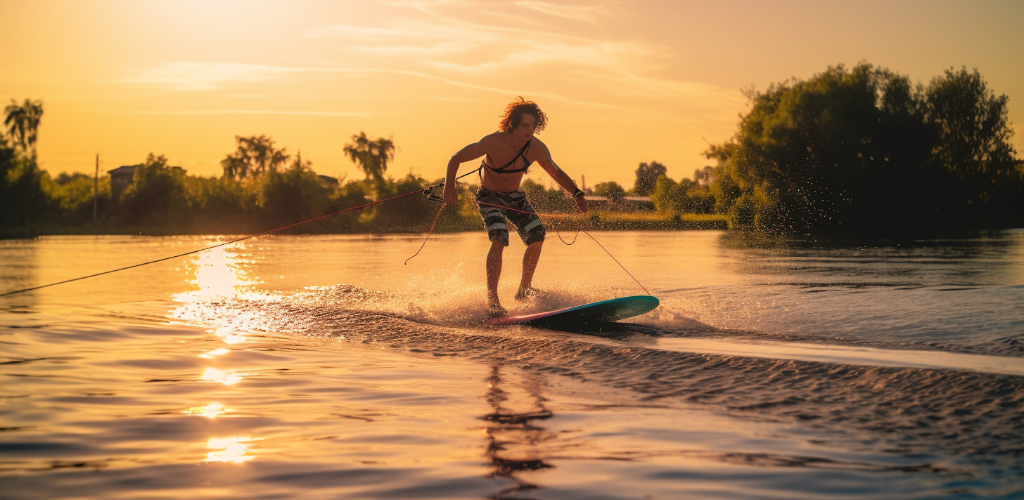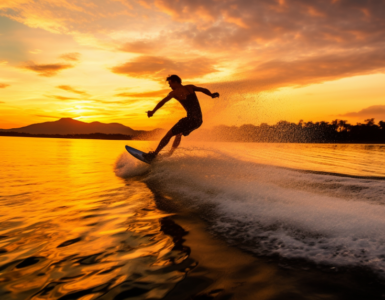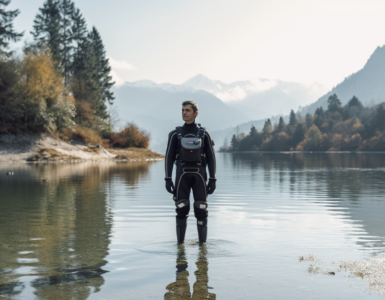Have you ever seen someone effortlessly gliding over the water on a wakeboard and thought, “I want to do that too!”? Well, you’re not alone. Wakeboarding is a thrilling water sport that has been gaining popularity over the years. However, as thrilling as it may be, it can also be quite challenging for beginners, especially when trying to get up on the wakeboard for the first time. But don’t worry, we’ve got you covered.
Understanding the Basics of Wakeboarding
Before you can start shredding waves, it’s crucial to understand the fundamentals of wakeboarding. The first thing you need is the right equipment. This includes the wakeboard itself, a tow rope, and a boat. The wakeboard should be the right size for your body weight and skill level, and the tow rope should be sturdy enough to withstand the pull of the boat.
Equally important is your positioning on the wakeboard. Your dominant foot should be placed towards the back of the board, while the other foot should be placed towards the front. This foot positioning is essential for maintaining balance as you glide over the water.
Don’t forget, wakeboarding isn’t just about strength and balance, it’s also about strategy and understanding how to use the equipment to your advantage. And that’s where the boat comes in.
The Role of the Boat in Wakeboarding
Did you know that the speed and path of the boat can significantly impact your wakeboarding experience? That’s right! The boat driver plays a crucial role in wakeboarding. Therefore, it’s important to establish good communication with the driver to ensure a smooth ride.
The boat should start at a slow pace and gradually increase speed as you feel more comfortable. Remember, it’s not about how fast you go, but how well you can control your wakeboard at varying speeds. So, are you ready to take the plunge?
The Step-by-Step Guide to Getting Up on a Wakeboard
So, you’ve got your wakeboard, you’re in the water, and you’re ready to go. But how do you actually get up on the wakeboard? Let’s break it down, step by step.
Positioning Yourself Correctly on the Wakeboard
First things first, you need to position yourself correctly on the wakeboard. Not sure how to do it? No worries, we’ve got you covered.
Your feet should be placed shoulder-width apart, with your back foot slightly more towards the tail of the board. Make sure your feet are centered between the edges of the board. Your bindings should be snug, but not too tight – you don’t want to cut off your circulation!
Are you a regular or goofy foot? If you naturally put your left foot forward, you’re a “regular”. If your right foot is your front foot, you’re “goofy”. Knowing this will help you set up your wakeboard correctly.
Acquiring the Correct Posture
Now that you’re positioned correctly on the board, let’s talk about posture. It’s not just about looking good on the water (although that’s a bonus!), having the right posture is crucial to successfully getting up on a wakeboard.
Start by floating in the water on your back with your knees bent and the board perpendicular to the tow rope. Keep your arms straight and let the boat do the work. As the boat starts to move, let the pull of the boat bring you up. Resist the urge to stand up too quickly – patience is key here!
Your chest should be up and your back straight. Think about keeping your weight centered over the board and remember to always look forward – where your eyes go, your body will follow.
Common Mistakes and How to Avoid Them
Now that we’ve covered the basics of getting up on a wakeboard, let’s talk about some common mistakes beginners tend to make and, more importantly, how to avoid them.
| Mistake | Solution |
|---|---|
| Standing up too quickly | Be patient and let the boat pull you up |
| Looking down | Always look forward where you want to go |
| Not keeping weight centered | Keep your weight balanced over the board |
| Bindings too tight or too loose | Make sure bindings are snug but comfortable |
| Incorrect foot positioning | Feet should be shoulder-width apart and centered on the board |
Strength and Conditioning for Wakeboarding
Have you ever thought about the amount of strength and flexibility required for wakeboarding? As a physically demanding sport, wakeboarding requires excellent core strength and flexibility. This is because these two aspects play a crucial role in maintaining balance and executing maneuvers on the wakeboard.
For instance, a strong core helps you maintain your balance on the wakeboard, making it easier to get up and stay up. Meanwhile, good flexibility allows you to bend and twist your body as needed, making it easier to perform tricks and avoid injuries.
So, what kind of training routine can you follow to improve these areas? A mix of strength training exercises like planks, squats, and lunges, combined with flexibility exercises like yoga and stretching, can significantly improve your wakeboarding performance. Remember, consistency is key!
Practice Drills for Getting Up on a Wakeboard
Just like any other sport, practice makes perfect in wakeboarding. The more you practice getting up on a wakeboard, the easier it will become. But what kind of practice drills can you do? Let’s take a look.
- Land Practice: Practicing your stance and balance on land can help you get used to the feeling before hitting the water. Try standing on the wakeboard on a soft surface and practice shifting your weight and balancing.
- Swim Start: This drill involves starting from the water with the board perpendicular to the tow rope. As the boat begins to pull, allow the board to swing around naturally and stand up gradually.
- Deep Water Start: The most common method of getting up on a wakeboard, this requires you to start in deep water with your knees pulled into your chest and the board facing the boat. As the boat pulls, lean back and allow the board to rise to the surface.
- Dry Land Tow: With the help of a friend, practice getting up on the wakeboard on dry land. Your friend pulls the rope while you practice standing up from a crouched position.
Remember, the key to successful practice drills is repetition. The more you practice, the more your body becomes accustomed to the movements, making it easier to get up on the wakeboard.
Overcoming Fear and Frustration
Wakeboarding, like any new sport, comes with a mixture of excitement and fear. It’s normal, right? But have you ever thought about how these emotions can affect your performance?
The fear of falling, of not getting it right, can often hold us back. But here’s the thing: falling is part of the learning process. Embrace it. Each fall is a stepping stone to your success. It’s not about how many times you fall, but how many times you get back on the board and try again. Sounds cliche, but it’s true!
Frustration is another mental hurdle that can affect your wakeboarding experience. It’s easy to get frustrated when you don’t succeed after several attempts. But remember, patience is key. You’re learning a new skill, and it takes time. Don’t rush the process. Celebrate your small victories. Got up on the board for a few seconds? That’s progress!
Progressing Your Wakeboarding Skills
So, you’ve finally managed to get up on the wakeboard. That’s fantastic! But what’s next?
Once you’re comfortable with getting up on the board and maintaining your balance, it’s time to take your wakeboarding skills to the next level. Here are a few things you can start to work on:
- Carving: This is where you move in a continuous path, like carving a path in the snow while skiing.
- Jumping: This involves getting air off the wake created by the boat. Start small, and gradually increase your height as you get more comfortable.
- Tricks: This is where you can really let your creativity shine. There are many tricks to learn, from basic spins to advanced flips.
Remember, progress is a gradual process. Take it one step at a time. Enjoy the journey!
Safety Tips for Wakeboarding
Before we wrap up, let’s talk about safety. After all, the thrill of wakeboarding should never compromise your safety.
First and foremost, always wear a life jacket. Even if you’re a good swimmer, a life jacket is essential when wakeboarding. You never know when you might need it.
Another important safety tip is to always have a spotter in the boat. This person’s job is to watch the rider and communicate with the boat driver, especially if the rider falls into the water.
Lastly, remember to warm up before you start wakeboarding. This will help prepare your muscles for the activity and reduce the risk of injury.
Wakeboarding is an exhilarating sport that can bring a lot of joy and satisfaction. So, keep these tips in mind, stay safe, and have fun out there!




